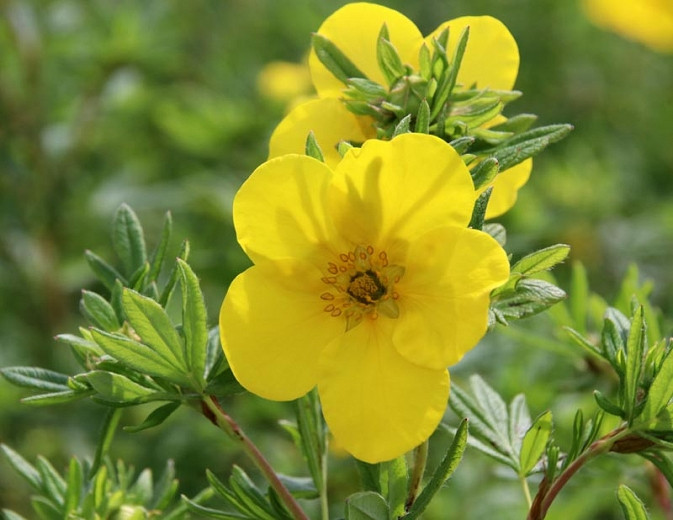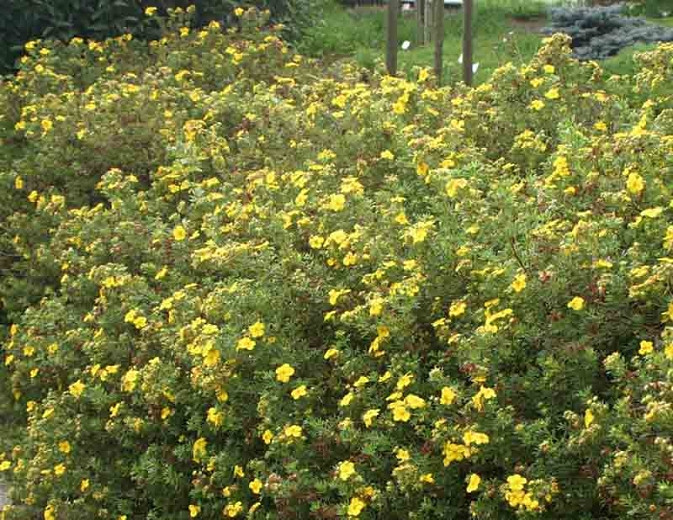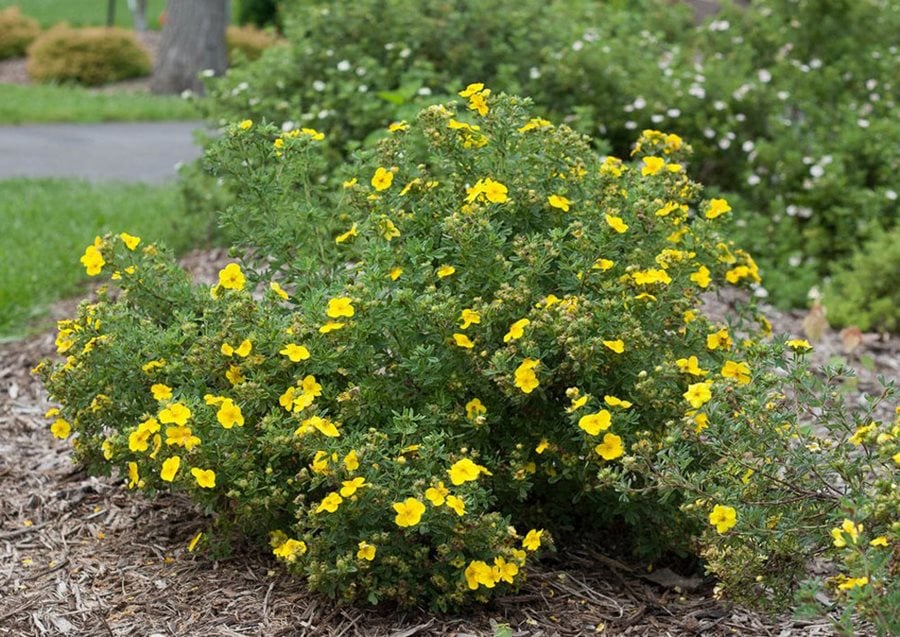Potentilla Fruticosa Goldfinger: The Ultimate Guide To Growing This Beautiful Shrub
Potentilla Fruticosa Goldfinger is a deciduous shrub that is known for its bright yellow flowers. It is a relatively easy plant to grow and care for, and it can be a beautiful addition to any garden.
In this blog post, we will provide you with an ultimate guide to growing Potentilla Fruticosa Goldfinger. We will cover everything from choosing the right location to planting and caring for your shrub.
Choosing the Right Location
Potentilla Fruticosa Goldfinger prefers full sun, but it can also tolerate partial shade. It is important to choose a location that gets at least 6 hours of sunlight per day. The soil should be well-drained and loamy.
Planting
Potentilla Fruticosa Goldfinger can be planted in the spring or fall. When planting, dig a hole that is twice as wide and as deep as the root ball. Backfill the hole with soil, tamping it down gently. Water the plant thoroughly after planting.
Caring for Your Shrub
Potentilla Fruticosa Goldfinger is a relatively low-maintenance plant. It requires regular watering, especially during the first year after planting. Water the plant deeply once a week, or more often during hot, dry weather.
You should also fertilize your shrub once a year in the spring. Use a balanced fertilizer, such as 10-10-10.
Potentilla Fruticosa Goldfinger does not require regular pruning. However, you may want to trim it back in the spring to remove any dead or damaged branches. You can also trim it to maintain its shape.
Pests and Diseases
Potentilla Fruticosa Goldfinger is generally resistant to pests and diseases. However, it can be susceptible to powdery mildew and aphids. If you notice any problems, you can treat them with an appropriate pesticide.
Propagation
Potentilla Fruticosa Goldfinger can be propagated by softwood cuttings in the spring or summer. To take a cutting, simply cut a 4-6 inch section of new growth from the plant. Remove the bottom leaves and dip the cutting in rooting hormone. Plant the cutting in a pot of well-draining soil and keep it moist. The cutting should root in a few weeks.
Conclusion
Potentilla Fruticosa Goldfinger is a beautiful and easy-to-grow shrub that can add a touch of brightness to any garden. With proper care, it will thrive for many years to come.
Potentilla fruticosa 'Goldfinger' is a beautiful, easy-care shrub that is perfect for adding color and interest to your garden. It blooms from late spring to fall with large, bright yellow flowers that contrast nicely against its dark green foliage. Shrubby cinquefoil is also very drought tolerant and can withstand a wide range of soil conditions.
If you are looking for a versatile and low-maintenance shrub, then Potentilla fruticosa 'Goldfinger' is a great choice. To learn more about this plant, please visit Home Gardening.
FAQ of potentilla fruticosa goldfinger
- What is Potentilla fruticosa Goldfinger?
Potentilla fruticosa Goldfinger is a deciduous shrub that is native to North America. It is known for its bright yellow flowers, which bloom from spring to fall. The shrub grows to be about 2-3 feet tall and wide, and it has a bushy, upright habit. Potentilla fruticosa Goldfinger is a relatively easy plant to care for, and it is drought-tolerant and deer-resistant. It is a popular choice for foundation plantings, borders, and hedges.
- Where does Potentilla fruticosa Goldfinger grow best?
Potentilla fruticosa Goldfinger prefers full sun or partial shade. It can grow in a variety of soil types, but it prefers well-drained soil. The shrub is drought-tolerant, but it will benefit from regular watering during the hot summer months.
- How do I care for Potentilla fruticosa Goldfinger?
Potentilla fruticosa Goldfinger is a relatively low-maintenance plant. It only needs to be watered deeply and infrequently. The shrub should be fertilized once a year in the spring with a balanced fertilizer. Deadheading spent flowers will encourage more blooms. Potentilla fruticosa Goldfinger can be pruned in the spring to shape the shrub or to remove any dead or damaged branches.
- What are some common pests and diseases of Potentilla fruticosa Goldfinger?
Potentilla fruticosa Goldfinger is a relatively pest- and disease-free plant. However, it can be susceptible to powdery mildew and aphids. Powdery mildew can be controlled by spraying the shrub with a fungicide. Aphids can be controlled by spraying the shrub with insecticidal soap or neem oil.
- How can I propagate Potentilla fruticosa Goldfinger?
Potentilla fruticosa Goldfinger can be propagated by softwood cuttings in the spring or fall. To take a softwood cutting, make a 4-6 inch cutting from a healthy branch. Remove the lower leaves from the cutting and dip the cut end in rooting hormone. Plant the cutting in a pot of well-drained potting mix. Keep the soil moist and the cutting in a warm, sunny location. The cutting should root in about 4-6 weeks.
Image of potentilla fruticosa goldfinger
10 different images of potentilla fruticosa goldfinger that are free to use:
- Image 1: A close-up of a single goldfinger potentilla flower. The flower is bright yellow with a slightly cupped shape. The petals are slightly overlapping and there are several dark yellow stamens in the center of the flower.

- Image 2: A full shot of a goldfinger potentilla shrub. The shrub is about 3 feet tall and has a rounded shape. The leaves are dark green and oval-shaped. The flowers are bright yellow and are clustered at the ends of the branches.

- Image 3: A goldfinger potentilla shrub in full bloom. The shrub is covered in bright yellow flowers. The flowers are so numerous that they almost obscure the leaves.

- Image 4: A goldfinger potentilla shrub planted in a garden. The shrub is surrounded by other flowers, including purple coneflowers, lavender, and daylilies.

- Image 5: A goldfinger potentilla shrub in a pot. The shrub is about 2 feet tall and is planted in a large terracotta pot. The pot is placed on a patio or deck.

- Image 6: A goldfinger potentilla shrub in a hedgerow. The shrub is planted in a row with other goldfinger potentilla shrubs. The hedgerow provides a colorful border for a garden.

- Image 7: A goldfinger potentilla shrub in a meadow. The shrub is planted in a meadow with other wildflowers, such as daisies, clover, and buttercups.

- Image 8: A goldfinger potentilla shrub in a woodland garden. The shrub is planted in a shady area of the garden with other shade-tolerant plants, such as ferns, hostas, and astilbe.

- Image 9: A goldfinger potentilla shrub in a pollinator garden. The shrub is planted in a garden that attracts bees, butterflies, and other pollinators. The flowers of the goldfinger potentilla are a favorite food of pollinators.

- Image 10: A goldfinger potentilla shrub in a fall garden. The shrub is still in bloom, even though most other flowers have finished blooming. The bright yellow flowers of the goldfinger potentilla provide a splash of color in the fall garden.

Post a Comment for "Potentilla Fruticosa Goldfinger: The Ultimate Guide To Growing This Beautiful Shrub"